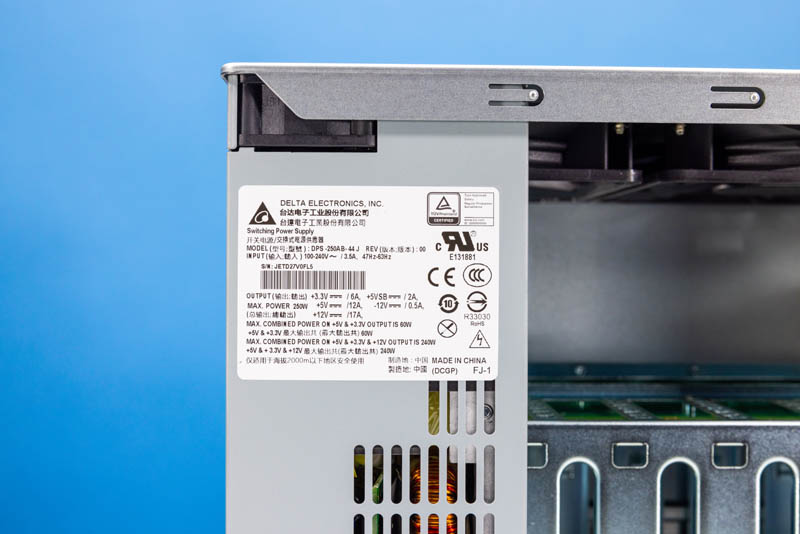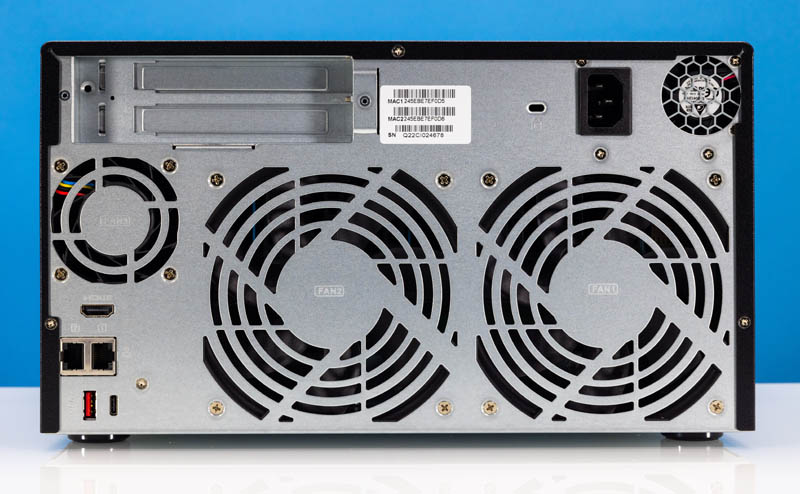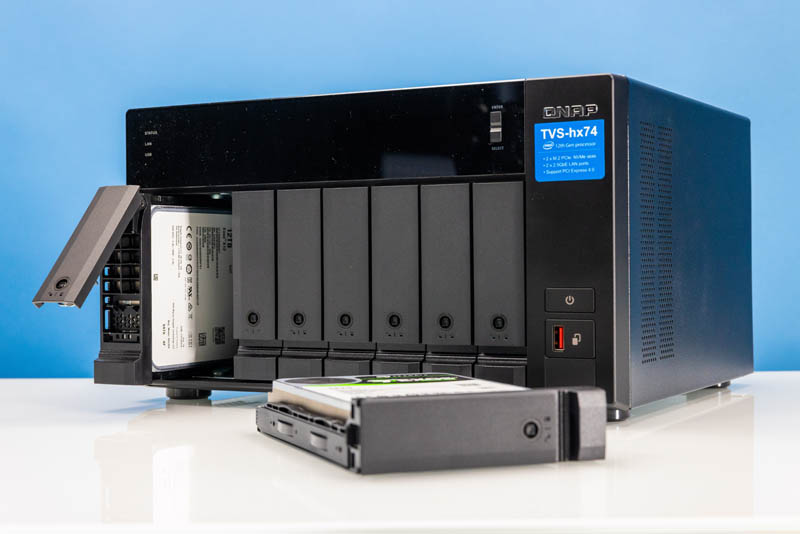QNAP TVS-h874 Power Consumption and Noise
Power consumption was very good. Actually, it could be said that the power consumption was surprising. When we saw the system’s 250W PSU and Intel Core i5-12400 processor, we thought it would be a power-hungry and noisy system. It was far from it.

We generally saw power consumption with 8x 18TB drives in the 54-60W range at the low end and just over 90W at the higher end during typical use. Doing things like running heavy benchmarks on the CPU, adding NVMe storage as well as high-end network cards, and more can increase those figures. QNAP’s ratings were 58W-82W typical so it seems like we were in that range.

The noise on this QNAP was exceptional. This is a case where hard drive access is louder and much more noticeable than the fan noise. We have heard folks comment that the CPU and motherboard fan can be noisy, but in our unit, under normal operation, it was very quiet raising our studio’s 34dba floor to 36dba.
Unlike many systems we have reviewed, this one can sit desktop. Our advice is that this ideally sits tucked away somewhere since you do not want it to move while in operation and the disk access noise dominates the noise profile of this machine.
Final Words
From a fit, finish, and performance perspective, the QNAP TVS-h874 is exactly what we would expect at this point from QNAP. We wish this had 10/25GbE, but QNAP’s solution is to use the two PCIe expansion slots. Also, in this price bracket, DDR4 makes sense still, but it feels like a ZFS NAS should have ECC memory.

On the subject of that price bracket, QNAP’s solution is currently retailing for around $2165 barebones. That is a fairly decent premium over the hardware that is going into this NAS. While we have some folks that will point out that they can build a NAS with an Intel Core i5-12400, the majority of NAS users buy pre-configured units. This system’s closest competition is probably the TueNAS Mini XL+. That unit is only $1600. QNAP has a much faster CPU, faster PCIe Gen4, an integrated GPU for transcoding support, and more expansion slots, but it lacks ECC memory and built-in 10GbE support. The overall platform performance is much higher than QNAP’s competition (and Synology hardware is usually several generations behind QNAP.) QNAP is charging a decent amount for the upgrade and easier-to-use software.
To us, it makes a lot of sense. QNAP has a package that one can unbox, plug drives into, and be up and running in minutes doing things like using QNAP snapshots, exporting ZFS pools, managing users, and more through easy-to-use wizards. The QNAP TVS-h874 is going to be a complete package that is going to resonate with a broad segment of the NAS market.



The review starts out saying “a ZFS NAS that is more exciting than we first expected” but somehow while reading I missed what was exciting. Was the exciting part lower power consumption and less noise than expected?
Lack of ECC memory is a show stopper in my opinion. Thanks for pointing this out. As far as I can tell the additional consistency checks in ZFS fail to reach typical ZFS levels of data safety without ECC. Is there an ECC option?
In my experience the difficulty with ready-made NAS devices is insecure software while finding a nice chassis with suitable drive bays is a problem for do it yourself.
Could this NAS hardware boot standard Linux or FreeBSD, not in a VM but on the bare metal? Testing such a capability would be a nice addition to the review.
Your analysis suggests that we can add ECC memory and that it will work. False!! It has been confirmed by Qnap that they have chosen to use a chipset not compatible with ECC even if the processor supports it. For reasons of economy? One thing is for sure is that there is a risk of data corruption using non-ECC memory with a ZFS system!!
The other thing you need to know is that Qnap have put a big power connector in line with the PCI slots. This poorly positioned connector prevents the use of cards with a very limited length. For example, an Nvidia P2000 or P2200 GPU card will not fit in this NAS. A QM2-4P-384 card will not fit either!!! Qnap has botched details!!
That motherboard is QNAP’s design so if they wanted ECC all they had to do was use the W680 and ECC SODIMMs.
Saying there’s a risk of data corruption using non-ECC memory with ZFS is disingenuous at best. If you use non-ECC memory, then ZFS is still better than most other filesystems because it will still detect bit flips and in some cases be able to repair them (e.g. from parity or mirror data). It is, after all, designed to detect bit flips on the disk and its controller, so if the bit flip happens in memory instead (after the data arrives from the disk) it’s no different to what ZFS was designed to handle.
There’s only a small set of scenarios where non-ECC memory will cause problems, and these affect all filesystems, not just ZFS.
There’s a good summary of the protections offered by ZFS on this post by Jim Salter, a renowned expert on ZFS: https://jrs-s.net/2015/02/03/will-zfs-and-non-ecc-ram-kill-your-data/
It gives some examples of how ECC memory certainly makes things more reliable, but it’s by no means mandatory for ZFS.
Not that I’m defending QNAP here of course. The cost for supporting ECC is so small it makes little sense to exclude it, but apparently we can thank Intel for that: https://arstechnica.com/gadgets/2021/01/linus-torvalds-blames-intel-for-lack-of-ecc-ram-in-consumer-pcs/
> the ATX 24-pin power supply goes into the hot-swap SATA backplane instead of directly into the motherboard
Article photos show opposite.
hello
Thanks for the review
I wish to see how a PCI Gen4 4x Cache drive would work with 2/4x10Gb/s Ethernet connections with overload.
It could be a nice option for Cinema/Video Post Production
@A, sorry – No. The article photos clearly show the 24pin connector going into the backplane, with either a 4 or 8-pin going to the CPU mainboard on the side.
Yes ECC is important with ZFS
https://ianhowson.com/zfs/ecc-ram/
And for the cost, there is no good reason to not add it to this NAS!!
For info the motherboard too have a connector!! Look the top view picture if you don’t trust me! And it interfer with PCIE cards.
@Malvineous: I’ve lost the data on the ZFS drive due to faulty non ECC RAM. The data I lost was older data and it was lost during scrub operation.
STH, Thanks, another solid review. I looked it over and there are a few QNAP “add in” cards (NvMe expansion & NICs & combos) that will work in this NAS per their website.
I have a QNAP 10Gig NIC card in my old TS-253D (vintage 2020) before the latest -X64 NAS. Along with the original NAS Base 2 x 2.5Gig NICs that’s a crazy amount of bandwidth.
I use link aggregation in this little managed NAS.
I used it extensively in my SOHO before I retired. Video production is just great.
My older 2bay Synology 1x1Gig NAS serves a different purpose and both suit my needs well.
Cheers.
Am I the only one who thinks a 12400 is a complete overkill for a NAS with hard drives